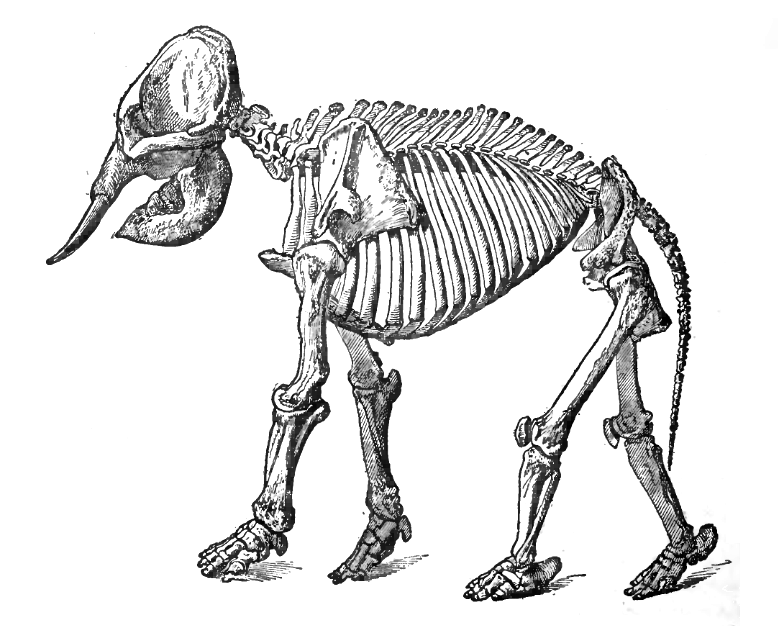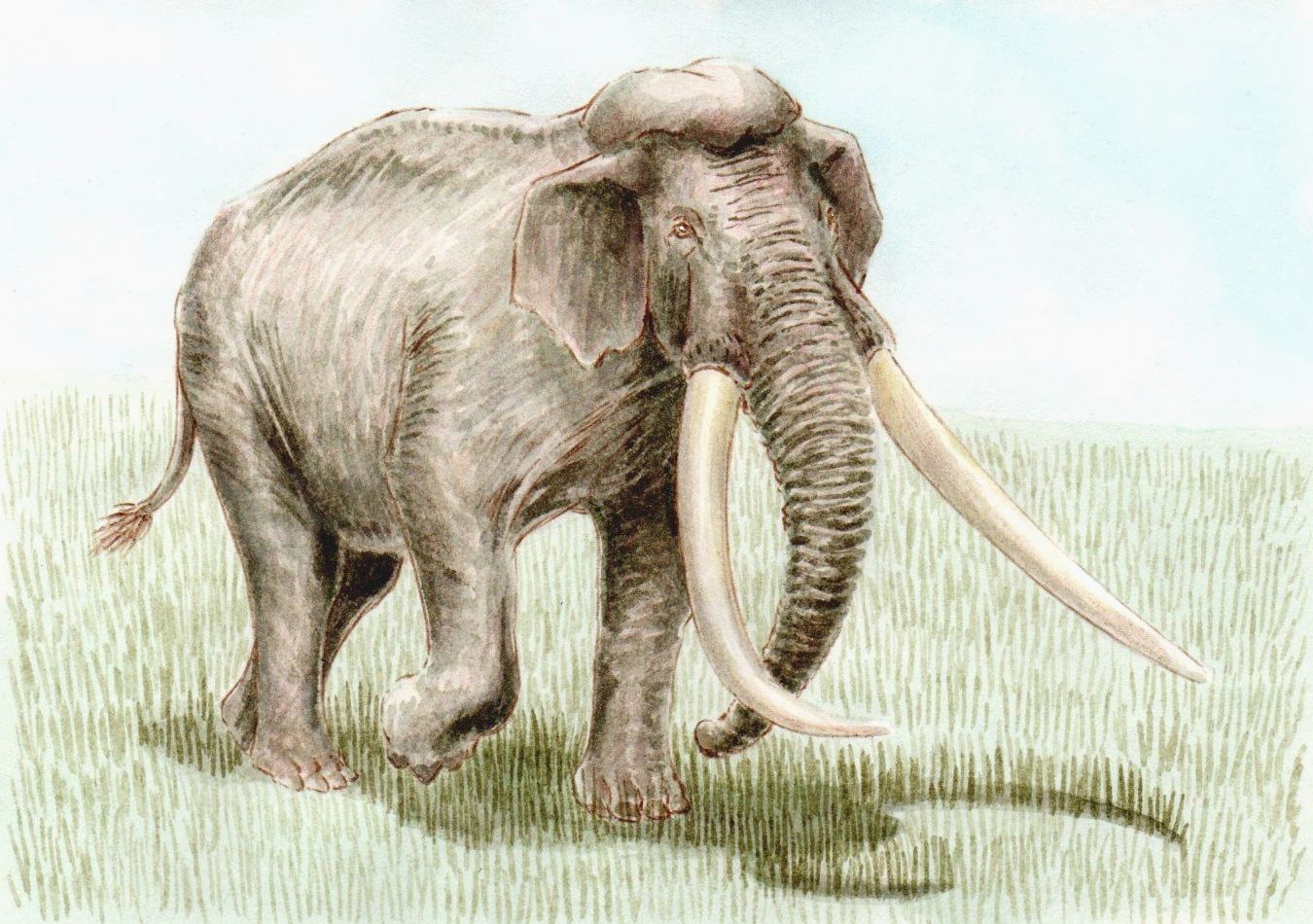|
Elephantidae
Elephantidae is a family of large, herbivorous proboscidean mammals collectively called elephants and mammoths. These are terrestrial large mammals with a snout modified into a trunk and teeth modified into tusks. Most genera and species in the family are extinct. Only two genera, '' Loxodonta'' (African elephants) and ''Elephas'' (Asiatic elephants), are living. The family was first described by John Edward Gray in 1821, and later assigned to taxonomic ranks within the order Proboscidea. Elephantidae has been revised by various authors to include or exclude other extinct proboscidean genera. Classification Scientific classification of Elephantidae taxa embraces an extensive record of fossil specimens, over millions of years, some of which existed until the end of the last ice age. Some species were extirpated more recently. The discovery of new specimens and proposed cladistics have resulted in systematic revisions of the family and related proboscideans. Elephantids are ... [...More Info...] [...Related Items...] OR: [Wikipedia] [Google] [Baidu] |
Elephant
Elephants are the largest existing land animals. Three living species are currently recognised: the African bush elephant, the African forest elephant, and the Asian elephant. They are the only surviving members of the family Elephantidae and the order Proboscidea. The order was formerly much more diverse during the Pleistocene, but most species became extinct during the Late Pleistocene epoch. Distinctive features of elephants include a long proboscis called a trunk, tusks, large ear flaps, pillar-like legs, and tough but sensitive skin. The trunk is used for breathing, bringing food and water to the mouth, and grasping objects. Tusks, which are derived from the incisor teeth, serve both as weapons and as tools for moving objects and digging. The large ear flaps assist in maintaining a constant body temperature as well as in communication. African elephants have larger ears and concave backs, whereas Asian elephants have smaller ears, and convex or level backs. Elepha ... [...More Info...] [...Related Items...] OR: [Wikipedia] [Google] [Baidu] |
Mammuthus Meridionalis
''Mammuthus meridionalis'', or the southern mammoth, is an extinct species of mammoth native to Europe and Central Asia from the Gelasian stage of the Early Pleistocene, living from 2.5–0.8 mya. Taxonomy The taxonomy of extinct elephants was complicated by the early 20th century, and in 1942, Henry Fairfield Osborn's posthumous monograph on the Proboscidea was published, wherein he used various taxon names that had previously been proposed for mammoth species, including replacing ''Mammuthus'' with ''Mammonteus'', as he believed the former name to be invalidly published. Mammoth taxonomy was simplified by various researchers from the 1970s onwards, all species were retained in the genus ''Mammuthus'', and many proposed differences between species were instead interpreted as intraspecific variation. The name ''Archidiskodon meridionalis'' is retained by some Russian researchers. Evolution The earliest known members of Proboscidea, the clade which contains modern elep ... [...More Info...] [...Related Items...] OR: [Wikipedia] [Google] [Baidu] |
Proboscidea
The Proboscidea (; , ) are a taxonomic order of afrotherian mammals containing one living family ( Elephantidae) and several extinct families. First described by J. Illiger in 1811, it encompasses the elephants and their close relatives. From the mid-Miocene onwards, most proboscideans were very large. The largest land mammal of all time may have been a proboscidean; '' Palaeoloxodon namadicus'' was up to at the shoulder and may have weighed up to , almost double the weight of some sauropods like '' Diplodocus carnegii''. The largest extant proboscidean is the African bush elephant, with a record of size of at the shoulder and . In addition to their enormous size, later proboscideans are distinguished by tusks and long, muscular trunks, which were less developed or absent in early proboscideans. Three species of elephant are currently recognised: the African bush elephant, the African forest elephant, and the Asian elephant. Elephantidae is the only surviving family o ... [...More Info...] [...Related Items...] OR: [Wikipedia] [Google] [Baidu] |
Proboscidean
The Proboscidea (; , ) are a taxonomic order of afrotherian mammals containing one living family (Elephantidae) and several extinct families. First described by J. Illiger in 1811, it encompasses the elephants and their close relatives. From the mid-Miocene onwards, most proboscideans were very large. The largest land mammal of all time may have been a proboscidean; '' Palaeoloxodon namadicus'' was up to at the shoulder and may have weighed up to , almost double the weight of some sauropods like '' Diplodocus carnegii''. The largest extant proboscidean is the African bush elephant, with a record of size of at the shoulder and . In addition to their enormous size, later proboscideans are distinguished by tusks and long, muscular trunks, which were less developed or absent in early proboscideans. Three species of elephant are currently recognised: the African bush elephant, the African forest elephant, and the Asian elephant. Elephantidae is the only surviving family of ... [...More Info...] [...Related Items...] OR: [Wikipedia] [Google] [Baidu] |
Mammoth
A mammoth is any species of the extinct elephantid genus ''Mammuthus'', one of the many genera that make up the order of trunked mammals called proboscideans. The various species of mammoth were commonly equipped with long, curved tusks and, in northern species, a covering of long hair. They lived from the Pliocene epoch (from around 5 million years ago) into the Holocene at about 4,000 years ago, and various species existed in Africa, Europe, Asia, and North America. They were members of the family Elephantidae, which also contains the two genera of modern elephants and their ancestors. Mammoths are more closely related to living Asian elephants than African elephants. The oldest representative of ''Mammuthus'', the South African mammoth (''M. subplanifrons''), appeared around 5 million years ago during the early Pliocene in what is now southern and eastern Africa. Descendant species of these mammoths moved north and continued to propagate into numerous subsequent ... [...More Info...] [...Related Items...] OR: [Wikipedia] [Google] [Baidu] |
Elephas Africanus - 1700-1880 - Print - Iconographia Zoologica - (white Background)
''Elephas'' is one of two surviving genera in the family of elephants, Elephantidae, with one surviving species, the Asian elephant, ''Elephas maximus''. Several extinct species have been identified as belonging to the genus, extending back to the Pliocene era. While formerly assigned to this genus, '' Elephas recki'', the straight-tusked elephant ''E. antiquus'' and the dwarf elephants '' E. falconeri'' and '' E. cypriotes'' are now placed in the separate genus ''Palaeoloxodon''. The genus is very closely related to the genus ''Mammuthus''. Taxonomy The scientific name ''Elephas'' was proposed by Carl Linnaeus in 1758 who described the genus and an elephant from Ceylon. The genus is assigned to the proboscidean family Elephantidae and is made up of one living and seven extinct species:Maglio, V.J. (1973). "Origin and evolution of the Elephantidae". ''Transactions of the American Philosophical Society, Philadelphia Volume 63''. American Philosophical Society, Philadelphia, pp. ... [...More Info...] [...Related Items...] OR: [Wikipedia] [Google] [Baidu] |
Elephas
''Elephas'' is one of two surviving genera in the family of elephants, Elephantidae, with one surviving species, the Asian elephant, ''Elephas maximus''. Several extinct species have been identified as belonging to the genus, extending back to the Pliocene era. While formerly assigned to this genus, '' Elephas recki'', the straight-tusked elephant ''E. antiquus'' and the dwarf elephants '' E. falconeri'' and '' E. cypriotes'' are now placed in the separate genus '' Palaeoloxodon''. The genus is very closely related to the genus ''Mammuthus''. Taxonomy The scientific name ''Elephas'' was proposed by Carl Linnaeus in 1758 who described the genus and an elephant from Ceylon. The genus is assigned to the proboscidean family Elephantidae and is made up of one living and seven extinct species:Maglio, V.J. (1973). "Origin and evolution of the Elephantidae". ''Transactions of the American Philosophical Society, Philadelphia Volume 63''. American Philosophical Society, Philadelphia, ... [...More Info...] [...Related Items...] OR: [Wikipedia] [Google] [Baidu] |
Asian Elephant
The Asian elephant (''Elephas maximus''), also known as the Asiatic elephant, is the only living species of the genus '' Elephas'' and is distributed throughout the Indian subcontinent and Southeast Asia, from India in the west, Nepal in the north, Sumatra in the south, and to Borneo in the east. Three subspecies are recognised—'' E. m. maximus'' from Sri Lanka, ''E. m. indicus'' from mainland Asia and '' E. m. sumatranus'' from the island of Sumatra. Formerly, there was also the Syrian elephant or Western Asiatic elephant (''Elephas maximus asurus'') which was the westernmost population of the Asian elephant (''Elephas maximus''). This subspecies became extinct in ancient times. Skeletal remains of ''E. m. asurus'' have been recorded from the Middle East: Iran, Iraq, Syria, and Turkey from periods dating between at least 1800 BC and likely 700 BC. It is one of only three living species of elephants or elephantids anywhere in the world, the others being the Africa ... [...More Info...] [...Related Items...] OR: [Wikipedia] [Google] [Baidu] |
Palaeoloxodon
''Palaeoloxodon'' is an extinct genus of elephant. The genus originated in Africa during the Pliocene era, and expanded into Eurasia during the Pleistocene era. The genus contains some of the largest known species of elephants, over four metres tall at the shoulders, including the European straight-tusked elephant (''Palaeoloxodon antiquus''), and the southern Asian '' Palaeoloxodon namadicus'', the latter of which was possibly the largest known land mammal based on fragmentary remains, but this requires proper reexamination. In contrast, the genus also contains many species of dwarf elephants that evolved via insular dwarfism on islands in the Mediterranean, some only a metre in height, making them the smallest elephants known. The genus has a long and complex taxonomic history, and at various times, it has been considered to belong to '' Loxodonta'' or ''Elephas'', but today is usually considered a valid and separate genus in its own right. Taxonomy In 1924, circumscribed '' ... [...More Info...] [...Related Items...] OR: [Wikipedia] [Google] [Baidu] |
Terrestrial Animal
Terrestrial animals are animals that live predominantly or entirely on land (e.g. cats, dogs, ants, spiders), as compared with aquatic animals, which live predominantly or entirely in the water (e.g. fish, lobsters, octopuses), and amphibians, which rely on a combination of aquatic and terrestrial habitats (e.g. frogs and newts). Some groups of insects are terrestrial, such as ants, butterflies, earwigs, cockroaches, grasshoppers and many others, while other groups are partially aquatic, such as mosquitoes and dragonflies, which pass their larval stages in water. Terrestrial animals tend to be more developed and intelligent than aquatic animals. Terrestrial classes The term "terrestrial" is typically applied to species that live primarily on the ground, in contrast to arboreal species, which live primarily in trees. There are other less common terms that apply to specific groups of terrestrial animals: * Saxicolous creatures are rock dwelling. "Saxicolous" is d ... [...More Info...] [...Related Items...] OR: [Wikipedia] [Google] [Baidu] |
10th Edition Of Systema Naturae
The 10th edition of ''Systema Naturae'' is a book written by Swedish naturalist Carl Linnaeus and published in two volumes in 1758 and 1759, which marks the starting point of zoological nomenclature. In it, Linnaeus introduced binomial nomenclature for animals, something he had already done for plants in his 1753 publication of ''Species Plantarum''. Starting point Before 1758, most biological catalogues had used polynomial names for the taxa included, including earlier editions of ''Systema Naturae''. The first work to consistently apply binomial nomenclature across the animal kingdom was the 10th edition of ''Systema Naturae''. The International Commission on Zoological Nomenclature therefore chose 1 January 1758 as the "starting point" for zoological nomenclature, and asserted that the 10th edition of ''Systema Naturae'' was to be treated as if published on that date. Names published before that date are unavailable, even if they would otherwise satisfy the rules. The onl ... [...More Info...] [...Related Items...] OR: [Wikipedia] [Google] [Baidu] |
_colourised.png)




.jpg)
